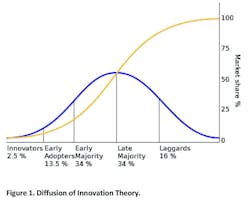Emerging Technologies in Ergonomics: Will You be Ready?
Many companies hire futurists to predict the game-changing technologies that will be widely used in the future. I’m not a futurist, nor do I want to be, but I appreciate how some ideas or concepts spread like wildfire while others don’t. As an experienced ergonomist working with Fortune 1000 companies across the globe, I’ve seen this happen with ergonomics management systems.
I find the “Diffusion of Innovation Theory,” developed by Everett M. Rogers, former professor and chair of the Department of Communication & Journalism at the University of New Mexico, quite interesting. His work analyzes how and why technology spreads, and at what rate new ideas and technology are adopted.
According to his theory, there are five adopter categories people fit into, with most of the population occupying the middle categories (see Figure 1):
1. The innovators are the individuals who take risks and have the closest contact with scientific sources and other innovators. Their risk tolerance allows them to adopt technologies that can ultimately fail.
2. Early adopters are those in leadership positions who have the vision to see the technology be successful. They are more judicious than innovators.
3. Those in the early majority category adopt new innovations or technologies in varying degrees of time. They focus on continuous improvement and want to see better processes implemented.
4. Late majority adopters approach innovation and technology with skepticism and will adopt them only after the majority does.
5. Laggards are the last ones to “get on board.” They typically avoid change and will not adopt the technology until no other options remain.
Diffusion of any technology manifests itself in different ways and is highly subject to the types of adopters and innovation-decision process. Regardless of what the technology is, it must be widely adopted to self-sustain, and at some point it reaches critical mass. Ultimately, as more and more people adopt it, the market share rises, sometimes to 100%.
A simple example of this is the prevalence of the smartphone. When it was introduced, it came with a larger, easy-to-view screen and had Internet capabilities; those features alone grabbed the attention of many. However, it wasn’t until the “boom” of all the apps, the video and high-resolution photo and video capabilities, and the ability to watch movies and play games that the smartphone became widespread. Now, many organizations require or purchase a smartphone for all employees. The original laggards are now walking around with a smartphone in their hands or pockets, all day long.
Such digital transformations have also occurred in the field of ergonomics. Not too long ago ergonomics was still managed using paper-based job assessment forms, education and training were conducted in-person, and no structured process or tracking of metrics were in place. The reports and data that were collected were probably stored and maintained in a spreadsheet located on someone’s computer. This method lacks visibility, and the data isn’t accessible to be shared easily across an organization. In reality, organizations using this method are more reactive in their overall process.
But that was then. Today, emerging technologies are enabling us to work faster, smarter and with more fidelity. Outlined below are four key technologies that are changing the way ergonomics is being practiced. As you read through them, ask yourself which category do you or your organization fit into?
Digital Transformation
Digital transformation in ergonomics means using a cloud-based platform to track and manage ergonomics training practices and data for your ergonomics program. Without this, companies will struggle to build a smart, efficient and effective process, one that leverages data and metrics to drive it.
The method gives instant visibility to all assessments, direct causes, improvements and follow-up assessments across all of your facilities and sites. It’s at your fingertips to be acted upon, but more importantly, it enables team members to communicate easily and in the same language as leaders. The key is to align the technology with the company’s safety management system and integrate it with the overall EHS program.
Even though this technology has been around for many years, it is still at the early adopter stage transitioning to early majority of adoption on the Diffusion of Innovation curve. As professionals continue to leverage digital platforms, they notice an alignment with their overall business goals. A study conducted by analyst firm IDC has shown that two-thirds of the CEOs of Global 2000 companies have digital transformation at the center of their corporate strategy. If it’s not already, it should be at the center of your strategic plan for EHS.
When selecting a platform, consider these key elements:
● Can it be used across the globe?
● Does the platform provide live real-time data and analytics?
● How easy is it to use?
● Does it have e-learning modules to help users develop competencies?
● Is your data safe and secure?
Wearable Sensors for Ergonomics Assessment
Sensors can be attached to an employee while the person is performing a work task. There are different versions of sensor-based technology in the market and many of them have been around for several years (e.g., electromyography). Some sensors are designed to help determine force application, while others gather electrical muscle activity and awkward posture measurements for certain body segments, and sometimes it’s used as a coaching tool.
This technology has a place, though most successful applications are limited to the research environment. On the Diffusion of Innovation curve, early innovators seem to be the ones using this technology, and field application is still limited.
Artificial Intelligence Using Computer Vision
This technology allows a user to assess an operation or a task using video, and no sensors or devices need to be placed on an employee’s body. It is not new, but its application in ergonomics is. This is game-changing. It improves the quality of the assessment, standardizes the process and engages individuals from other departments to participate in the ergonomics process.
Traditionally, ergonomics assessments were conducted through manual observation. There were challenges with this method, including inaccuracies and inconsistencies among assessors (we all see things differently), and it’s a time-consuming process. Computer-vision technology uses artificial intelligence, and through deep learning, it sees what the human eye can’t, in fractions of a second.
On the Diffusion of Innovation curve, this technology is at an early adopter stage, but with a huge potential to be used by the masses quickly. The broader impact this technology could have on the field of ergonomics is unimaginable and people will start to find different ways to apply it in their organizations.
Exoskeletons and Exosuits
The goal of these wearable robots is to reduce the burden and load on an employee in an effort to reduce injuries. Have you seen the “Iron Man” movies? Though far from reality for manufacturing applications, the real impact on the person is still unknown and being researched.
The American Society for Testing and Materials (ASTM), an international standards organization, develops and publishes voluntary consensus technical standards for a wide range of materials, products, systems and services. Its F48 committee is developing voluntary consensus standards for exoskeletons and exosuits, addressing issues such as safety, quality, performance, ergonomics and terminology during the full lifecycle of the product, from before use to maintenance and disposal, as well as security and information technology considerations. In addition, they research passive and active systems, enhancing and decreasing effects systems, as well as systems with physical and cognitive integration. The committee’s work is ongoing, and the benefits and drawbacks of using these devices are still being discovered.
On the Diffusion of Innovation curve, this technology is at an early adopter stage; they are being piloted by many companies to better understand their use within operations. Some initial findings show inconclusive results. Personally, I want this technology to be successful and become commonplace as the core reason of using them is to reduce burden on employees, though it might be years before its mass adoption.
Technology and innovation are always exciting and there is often a lot of buzz associated with them. The key point to remember is to be strategic with your implementation efforts and understand market adoption profiles.
Deepesh Desai, CPE, is director of consulting and ergonomics engineer for Humantech, a VelocityEHS company. He leads a team of ergonomists to develop, manage and sustain global ergonomics programs using software solutions for Fortune 1000 clients across various industries, including aerospace, automotive, pharmaceutical, consumer products, petroleum, food & beverage, steel, and heavy-vehicle manufacturing.
About the Author
Deepesh Desai
director of consulting and ergonomics engineer
Deepesh Desai, CPE, is director of consulting and ergonomics engineer for Humantech, a VelocityEHS company. He leads a team of ergonomists to develop, manage and sustain global ergonomics programs using software solutions for Fortune 1000 clients across various industries, including aerospace, automotive, pharmaceutical, consumer products, petroleum, food & beverage, steel, and heavy-vehicle manufacturing.

